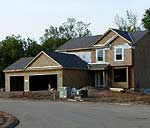By Mike Edgerly
Minnesota Public Radio
June 3, 2002
The 2000 U.S. Census shows the 1990s were prosperous years in Minnesota. Census figures released Monday show per person and household incomes were up, while the number of families living in poverty declined.
| |
|
|
|
||
From 1990 to 2000, more Minnesotans became homeowners - and more of us owned homes valued at more than $200,000. The number of high school dropouts declined, while the number of people with bachelor's and advanced degrees grew significantly.
The census data was collected in April 2000, nearly a year before the state entered a recession. The survey, sent to roughly one in six households, shows the last decade of the 20th century was a boom period for the state.
"Minnesota is simply a very successful state - in terms of its economy and its growth, and high level of education and income, and low poverty rate. It's simply a very successful state, and remarkably so by national standards," says Tom Gillaspy, the state's demographer.
More
NATIONAL RANKINGS
Minnesota ranked sixth in the nation in income growth in the 1990s. The census shows the state's per capita income grew 61 percent between 1990 and 2000, to $23,198 - 11th highest in the nation.
More
| |
|
|
|
||
INCOME AND POVERTY
Statewide, the median income per person rose 24.2 percent, to $23,198. For households, the median income rose 17.4 percent to $47,111.
Swift County reported the biggest increase in household income. The median family income in that western Minnesota county jumped 43.2 percent to $34,820. Scott County is the wealthiest county in the state as measured by household income at $66,612, a nearly 26 percent increase over the past 10 years. Mahnomen County reported the lowest median household income, at $30,053, even though that's a 36.8 percent increase from the last census.
While incomes increased in all areas of the state, the number of individuals living below the poverty line declined by 12.6 percent. The number of families living below the poverty line declined 22.6 percent since the last census. Every Minnesota county but one reported a decline.
South Dakota had the largest increase in the nation for household median income. But South Dakota still has the poorest county in the nation, even though it had a 57 percent growth in median income.
More
| |
|
|
|
||
HOUSING
Home ownership also increased. The census reports Minnesotans owned 1,117,489 homes in 2000, a 65 percent increase since 1990, more than twice the rate of inflation for the same period.
The value of homes also grew. In 2000, the median value of a home was $122,400, an increase of 29 percent. The highest home value is in Carver County, where the median value of a home is $170,000, representing a 39 percent increase.
The number of homes valued at more than $200,000 grew 470 percent, from 30,329 to 172,969. The value of homes in Swift County grew 66 percent, the greatest increase in the state. The median value of a home in Swift County is $58,200.
Census data released a year ago showed Minnesota ranked second nationally in the rate of home ownership.
| |
|
|
|
||
EDUCATION
Educational attainment increased in several categories. While the number of Minnesotans with a high school degree or equivalency remained stable, the number of Minnesotans who reported getting no high school diploma declined 11 percent, from 249,443 in 1990 to 222,487. Still, six counties reported double-digit increases in the number of dropouts.
Pine County reported a 19 percent increase, from 2,051 in 1999 to 2,449 in 2000. Red Lake County reported the biggest decline with 246 dropouts, a drop of 41 percent. The number of Minnesotans who reported getting less than a ninth grade education dropped 34 percent from 1990.
The number of Minnesotans attending and completing college also grew during the 1990s. There was a 44 percent increase in the number of people who attended some college, while the number of Minnesotans with bachelor's degrees grew 40 percent. The biggest percentage increase, 52 percent, was among those who reported holding a graduate or professional degree.
More
| |
|
|
|
||
IMMIGRATION
Minnesota remains a destination for international immigrants. According to census data, the state became home to 260,463 foreign-born residents in the 1990s. That's an increase of 130 percent. Hennepin and Ramsey counties are home to the largest number of immigrants. Hennepin County saw an increase of 150 percent, to 110,496. In Ramsey County, the number of foreign born immigrants increased 98 percent to 54,263.
Non-metro communities also registered growth among immigrants. Scott County recorded the biggest influx with more than 3,000 new foreign-born residents, an increase of 570 percent. Le Sueur County gained 359 immigrant residents, a gain of 359 percent.
More
| |
|
|
|
||
COMMUTING AND TRANSPORTATION
Travel times for commuters grew significantly the past 10 years. Many counties, many of them outside the Twin Cities metro area, reported double-digit increases in commute times.
Statewide, the average commute time was 21.9 minutes, a 15 percent increase. In Todd County, the average commute time was 23.2, compared to just over 15 minutes 10 years ago. That's a 51 percent increase, the biggest increase for any county in the state.
Pine County residents have the longest average commute time at 30.2 minutes, a 27 percent increase since 1990. Anoka, Wright, Sherburne and Carver counties in the metro area all registered average travel times approaching a half hour.
The increase in commute times could be linked to the increased number of drivers who are traveling solo to work. The census found a 24 percent increase in the number of people who reported commuting alone. Solo commuters in 2000 totaled 1,971,668.
The census found a slight increase in the number of people who use public transportation. Statewide, 81,276 people reported using public transportation to commute, an increase of 5 percent. Carpooling also grew slightly, by 7 percent, to 264,690 people.
The commute numbers also reflect a bigger work force. Minnesota had 2,541,611 workers over the age of 16 in 2000, an 18 percent increase over 1990.
More






